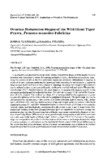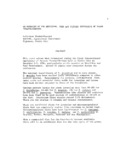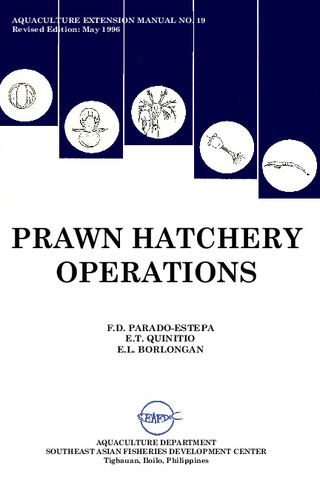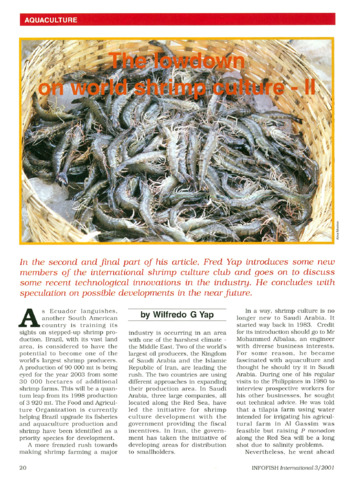Ovarian maturation stages of the wild giant tiger prawn, Penaeus monodon Fabricius
Share
Abstract
A qualitative and quantitative study of the ovarian maturation stages of wild-caught Penaeus monodon was conducted to refine the existing method of staging. For industrial purpose, measuring the ovarian width at the first abdominal region can minimize arbitrariness in staging. A width of 20 mm indicates readiness for spawning while reproductive performance is improved when ovarian width is 30 mm or more. Based on histology, the usual 6 to 8 stages of development can be reduced to four stages: previtellogenic, vitellogenic, cortical rod, and spent. The previtellogenic stage (P) is characterized by the predominance of oogonia and primary oocytes in the chromatin nucleolus and/or perinucleolus stage. The vitellogenic stage (V) is marked by the presence of yolky oocytes. The cortical rod stage (C) is distinguished by the appearance of yolky oocytes with spherical or rod-like bodies at the peripheral cytoplasm. The spent stage (S) can be distinguished by the presence of few oocytes with yolky substance and/or cortical rods, thicker layers of follicle cells, and few darkly-stained, irregularly shaped primary oocytes. Individuals classified as stages II+ and III+ showed similarity in size and shape of all lobes in the posterior thoracic region, and histologically, corresponded to the revised stages V and C, respectively. Histochemical staining shows that glycoproteins and lipids are absent in the primary oocytes and present in yolky oocytes. Glycoproteins but not lipids occur in the cortical rods. Analysis of variance showed significant differences in mean gonad weight and gonadosomatic index values but not in the mean body length and body weight values in stages P to C. Uniformity in the number, stage and composition of oocytes in the four regions of the ovary at each stage showed that stage of ovarian maturity in wildprawns can be represented by any region of the ovary. Differences in the oocyte size frequency and mean values of average and maximum oocyte diameter in the four stages showed that these are good indicators of stage of maturation in wild P. monodon.
Description
SEAFDEC Aquaculture Department Contribution No. 233.
Suggested Citation
Tan-Fermin, J. D., & Pudadera, R. A. (1989). Ovarian maturation stages of the wild giant tiger prawn, Penaeus monodon Fabricius. Aquaculture , 77(2-3), 229-242. https://doi.org/10.1016/0044-8486(89)90205-6
Subject
Taxonomic term
Collections
- AQD Journal Articles [1249]
Related items
Showing items related by title, author, creator and subject.
-
An overview of the nutrition, feed and feeding techniques of prawn penaeid/shrimps
Piedad-Pascual, Felicitas (Philippine Council for Aquatic and Marine Research and Development, 1989)This paper echoes what transpired during the first International Conference of Penaeid Prawns/Shrimps held in Iloilo City in December 4-7, 1984, particularly on the Nutrition nd Feed Development. Around 25 papers were ... -
Prawn hatchery operations
Parado-Estepa, Fe D.; Quinitio, Emilia T.; Borlongan, Emeterio L. (Aquaculture Department, Southeast Asian Fisheries Development Center, 1996-05)The manual, an updated version of the 1984 SEAFDEC/AQD manual, presents the underlying principles and step-by-step instructions of prawn larval and post-larval rearing. The techniques described are not only applicable to ... -
The lowdown on world shrimp culture - II
Yap, Wilfredo G. (INFOFISH, 2001)This paper introduces some new members of the international shrimp culture club and goes on to discuss some recent technological innovations in the industry, particularly the polyculture of tilapia (mainly Oreochromis ...




